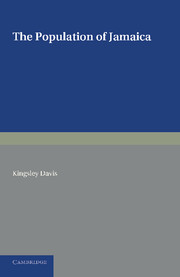Book contents
- Frontmatter
- The Conservation Foundation
- Contents
- List of Figures
- List of Tables
- Preface
- INTRODUCTION
- CHAPTER 1 DEMOGRAPHIC MATERIAL AVAILABLE
- CHAPTER 2 GROWTH OF THE POPULATION
- CHAPTER 3 MAJOR CHARACTERISTICS OF THE POPULATION
- CHAPTER 4 CURRENTS OF EXTERNAL MIGRATION
- CHAPTER 5 INTERNAL MIGRATION
- CHAPTER 6 MORTALITY
- CHAPTER 7 CHANGING PATTERNS OF REPRODUCTION
- CHAPTER 8 FERTILITY, MATING AND ILLEGITIMACY
- CHAPTER 9 GROWTH PROSPECTS
- APPENDICES
- Index of Names
- Index of Subjects
CHAPTER 3 - MAJOR CHARACTERISTICS OF THE POPULATION
Published online by Cambridge University Press: 05 June 2016
- Frontmatter
- The Conservation Foundation
- Contents
- List of Figures
- List of Tables
- Preface
- INTRODUCTION
- CHAPTER 1 DEMOGRAPHIC MATERIAL AVAILABLE
- CHAPTER 2 GROWTH OF THE POPULATION
- CHAPTER 3 MAJOR CHARACTERISTICS OF THE POPULATION
- CHAPTER 4 CURRENTS OF EXTERNAL MIGRATION
- CHAPTER 5 INTERNAL MIGRATION
- CHAPTER 6 MORTALITY
- CHAPTER 7 CHANGING PATTERNS OF REPRODUCTION
- CHAPTER 8 FERTILITY, MATING AND ILLEGITIMACY
- CHAPTER 9 GROWTH PROSPECTS
- APPENDICES
- Index of Names
- Index of Subjects
Summary
Inevitably the demographic characteristics of a country must be powerfully influenced by the pattern of its historical development. This is very clearly demonstrated in the case of Jamaica. Above all, its long history of slavery, extending for 178 years of the three centuries of British rule, has had important and long-lasting effects on its population. Population growth in the days of slavery was, as we have already seen, largely determined by two historical factors, the slave trade and the policy of increasing the white population for reasons of security. But, as will appear in the course of this chapter, the influence of slavery was evident in many phases of population structure long after its abolition. Even demographic characteristics such as sex and age, which ultimately are to a large degree determined by strictly biological factors, did not escape the pervasive influence of the slave trade. Its effects on mating habits, perhaps the most indelible marks of slavery on the island's population, will be considered in Chapter 7.
But slavery is not the only historical element to be reckoned with in analysing the demographic position of the island. For instance, even though indenture immigration into Jamaica was of only small importance compared with the part it played in determining population movements in the eastern Caribbean, it still produced the small but important influx of East Indian and Chinese immigrants, which has affected not only the racial composition of the population, but also the economic and social structure of the island as well. Similarly, the decline of sugar as the staple of the island in the nineteenth century and the rise of the fruit trade were of some consequence for the demography of the island, in particular stimulating external migration, which in turn altered appreciably the sex composition of the population and retarded its rate of growth.
It is not intended here to treat explicitly the interrelation between historical development such as those outlined above and demographic movements in the island. But for the purpose of the analysis of its major demographic features offered in this chapter—age structure, racial and sex composition, education and occupational status—it is well to recall the historical roots of many of the distinctive patterns that emerge.
- Type
- Chapter
- Information
- The Population of Jamaica , pp. 59 - 100Publisher: Cambridge University PressPrint publication year: 2013



